2009 CHEVROLET UPLANDER seats
[x] Cancel search: seatsPage 165 of 464

The main components of the instrument panel are the following:
A.Outlet Adjustment on page 3-27.
B.Turn Signal/Multifunction Lever on page 3-7.
C.Audio Steering Wheel Controls on page 3-111
(If Equipped).
D.Instrument Panel Cluster on page 3-31.
E.Driver Information Center (DIC) on page 3-43
(If Equipped).
F.Traction Control System (TCS) on page 4-6
(If Equipped).
G.Hazard Warning Flashers on page 3-6.
H.Passenger Airbag Status Indicator on page 3-34
andSafety Belt Reminders on page 3-32.
I.Audio System(s) on page 3-76.J.Exterior Lamps on page 3-13.
K.Interior Lamps Control on page 3-15.Instrument
Panel Brightness on page 3-15.
L.Hood Release on page 5-13.
M.Parking Brake on page 2-38.
N.Horn on page 3-6.
O.Cruise Control on page 3-10(If Equipped).
P.Climate Control System on page 3-22.Dual Climate
Control System on page 3-25.
Q.Heated Seats on page 1-3(If Equipped).
R.Glove Box on page 2-55.
3-5
Page 178 of 464

Electric Power Management
The vehicle has Electric Power Management (EPM)
that estimates the battery’s temperature and state
of charge. It then adjusts the voltage for best
performance and extended life of the battery.
When the battery’s state of charge is low, the voltage is
raised slightly to quickly put the charge back in. When the
state of charge is high, the voltage is lowered slightly to
prevent overcharging. If the vehicle has a voltmeter gage
or a voltage display on the Driver Information Center
(DIC), you may see the voltage move up or down. This is
normal. If there is a problem, an alert will be displayed.
The battery can be discharged at idle if the electrical
loads are very high. This is true for all vehicles. This is
because the generator (alternator) may not be
spinning fast enough at idle to produce all the power
that is needed for very high electrical loads.A high electrical load occurs when several of the
following loads are on: headlamps, high beams, fog
lamps, rear window defogger, climate control fan at
high speed, heated seats, engine cooling fans, trailer
loads, and loads plugged into accessory power outlets.
EPM works to prevent excessive discharge of the
battery. It does this by balancing the generator’s output
and the vehicle’s electrical needs. It can increase engine
idle speed to generate more power, whenever needed.
It can temporarily reduce the power demands of some
accessories.
Normally, these actions occur in steps or levels, without
being noticeable. In rare cases at the highest levels of
corrective action, this action may be noticeable to the
driver. If so, a Driver Information Center (DIC) message
might be displayed, such as Battery Saver Active or
Service Battery Charging System. If this message is
displayed, it is recommended that the driver reduce the
electrical loads as much as possible. SeeDIC Warnings
and Messages on page 3-51.
3-18
Page 181 of 464
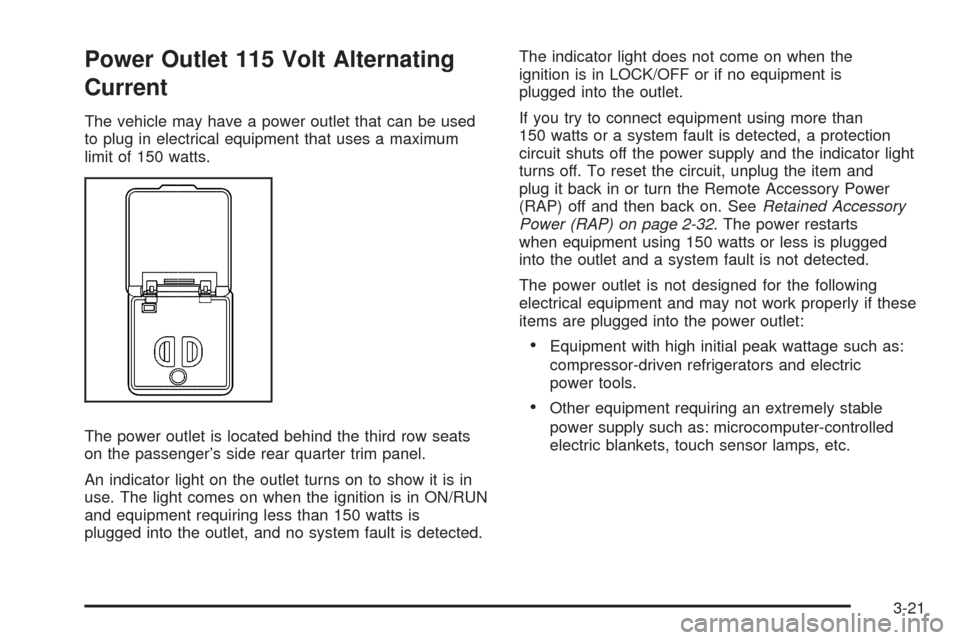
Power Outlet 115 Volt Alternating
Current
The vehicle may have a power outlet that can be used
to plug in electrical equipment that uses a maximum
limit of 150 watts.
The power outlet is located behind the third row seats
on the passenger’s side rear quarter trim panel.
An indicator light on the outlet turns on to show it is in
use. The light comes on when the ignition is in ON/RUN
and equipment requiring less than 150 watts is
plugged into the outlet, and no system fault is detected.The indicator light does not come on when the
ignition is in LOCK/OFF or if no equipment is
plugged into the outlet.
If you try to connect equipment using more than
150 watts or a system fault is detected, a protection
circuit shuts off the power supply and the indicator light
turns off. To reset the circuit, unplug the item and
plug it back in or turn the Remote Accessory Power
(RAP) off and then back on. SeeRetained Accessory
Power (RAP) on page 2-32. The power restarts
when equipment using 150 watts or less is plugged
into the outlet and a system fault is not detected.
The power outlet is not designed for the following
electrical equipment and may not work properly if these
items are plugged into the power outlet:
Equipment with high initial peak wattage such as:
compressor-driven refrigerators and electric
power tools.
Other equipment requiring an extremely stable
power supply such as: microcomputer-controlled
electric blankets, touch sensor lamps, etc.
3-21
Page 182 of 464
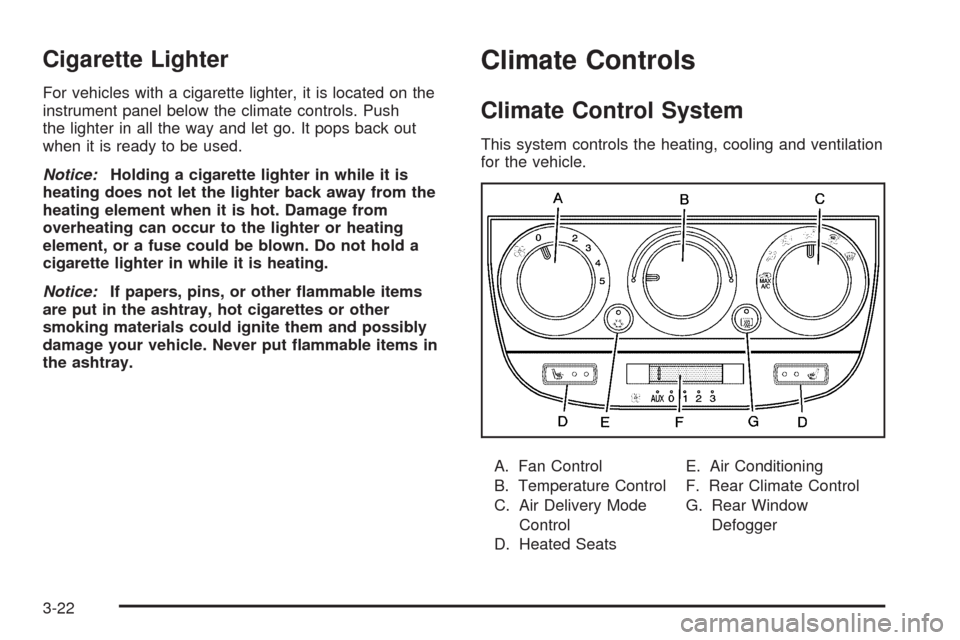
Cigarette Lighter
For vehicles with a cigarette lighter, it is located on the
instrument panel below the climate controls. Push
the lighter in all the way and let go. It pops back out
when it is ready to be used.
Notice:Holding a cigarette lighter in while it is
heating does not let the lighter back away from the
heating element when it is hot. Damage from
overheating can occur to the lighter or heating
element, or a fuse could be blown. Do not hold a
cigarette lighter in while it is heating.
Notice:If papers, pins, or other �ammable items
are put in the ashtray, hot cigarettes or other
smoking materials could ignite them and possibly
damage your vehicle. Never put �ammable items in
the ashtray.
Climate Controls
Climate Control System
This system controls the heating, cooling and ventilation
for the vehicle.
A. Fan Control
B. Temperature Control
C. Air Delivery Mode
Control
D. Heated SeatsE. Air Conditioning
F. Rear Climate Control
G. Rear Window
Defogger
3-22
Page 183 of 464
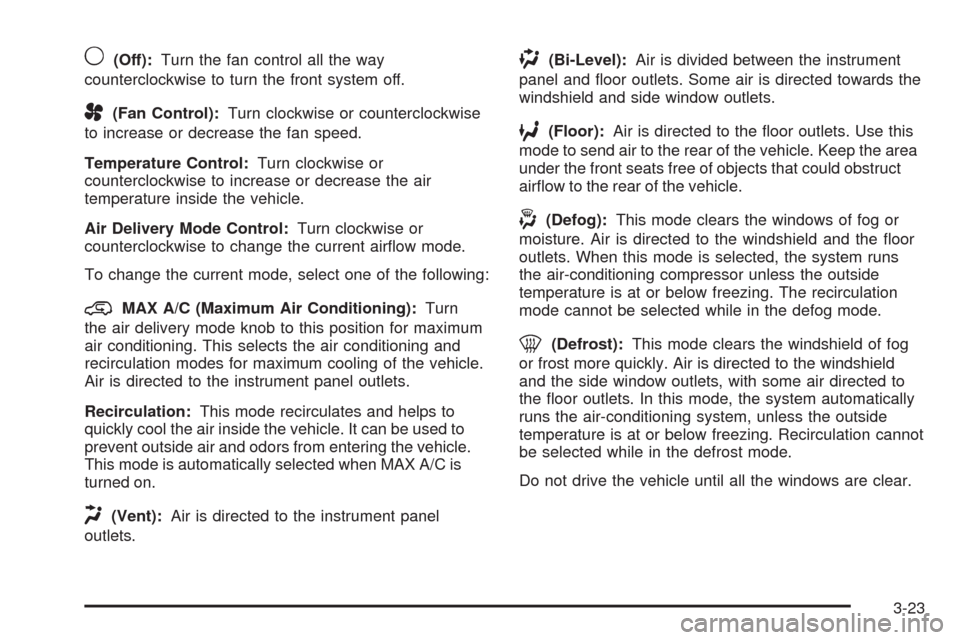
9(Off):Turn the fan control all the way
counterclockwise to turn the front system off.
A(Fan Control):Turn clockwise or counterclockwise
to increase or decrease the fan speed.
Temperature Control:Turn clockwise or
counterclockwise to increase or decrease the air
temperature inside the vehicle.
Air Delivery Mode Control:Turn clockwise or
counterclockwise to change the current air�ow mode.
To change the current mode, select one of the following:
@MAX A/C (Maximum Air Conditioning):Turn
the air delivery mode knob to this position for maximum
air conditioning. This selects the air conditioning and
recirculation modes for maximum cooling of the vehicle.
Air is directed to the instrument panel outlets.
Recirculation:This mode recirculates and helps to
quickly cool the air inside the vehicle. It can be used to
prevent outside air and odors from entering the vehicle.
This mode is automatically selected when MAX A/C is
turned on.
H(Vent):Air is directed to the instrument panel
outlets.
)(Bi-Level):Air is divided between the instrument
panel and �oor outlets. Some air is directed towards the
windshield and side window outlets.
6(Floor):Air is directed to the �oor outlets. Use this
mode to send air to the rear of the vehicle. Keep the area
under the front seats free of objects that could obstruct
air�ow to the rear of the vehicle.
-(Defog):This mode clears the windows of fog or
moisture. Air is directed to the windshield and the �oor
outlets. When this mode is selected, the system runs
the air-conditioning compressor unless the outside
temperature is at or below freezing. The recirculation
mode cannot be selected while in the defog mode.
0(Defrost):This mode clears the windshield of fog
or frost more quickly. Air is directed to the windshield
and the side window outlets, with some air directed to
the �oor outlets. In this mode, the system automatically
runs the air-conditioning system, unless the outside
temperature is at or below freezing. Recirculation cannot
be selected while in the defrost mode.
Do not drive the vehicle until all the windows are clear.
3-23
Page 184 of 464

#(Air Conditioning):Press to turn the air
conditioning system on or off. The fan must be on to
operate the air conditioning. An indicator light comes
on when the air conditioning is on.
A slight change in engine performance may be
noticeable when the air conditioning compressor shuts
off and turns on again. This is normal. The system
is designed to make adjustments to help with fuel
economy while still maintaining the selected
temperature.
On hot days, open the windows to let hot inside air
escape; then close them. This helps to reduce the time
it takes for the vehicle to cool down so the system
operates more efficiently.
The air conditioning system removes moisture from
the air, so a small amount of water might drip under
the vehicle while idling or after turning off the engine.
This is normal.
Outside Air:Outside air is automatically selected in
any mode, except maximum air conditioning.Rear Window Defogger
The rear window defogger uses a warming grid to
remove fog from the rear window.
when the rear window defogger is on.
The rear window defogger turns off about 15 minutes
after the button is pressed. If turned on again, the
defogger will only run for about �ve minutes before
turning off. The defogger can also be turned off
by turning off the engine.
Notice:Do not use anything sharp on the inside of
the rear window. If you do, you could cut or damage
the warming grid, and the repairs would not be
covered by the vehicle warranty. Do not attach a
temporary vehicle license, tape, a decal or anything
similar to the defogger grid.
((Heated Seats):Press to turn on the heated seats.
SeeHeated Seats on page 1-3for additional information.
3-24
Page 185 of 464
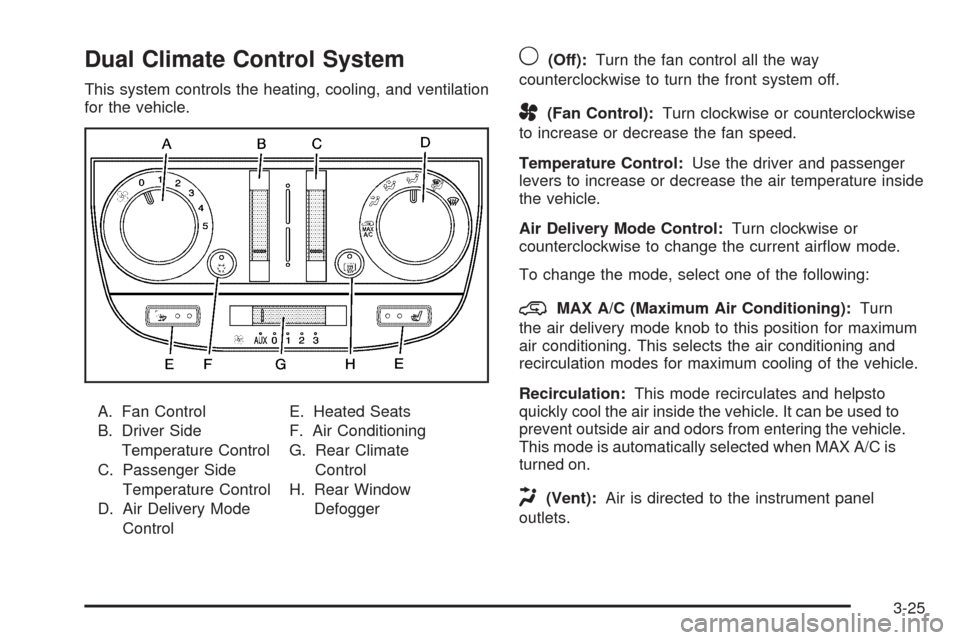
Dual Climate Control System
This system controls the heating, cooling, and ventilation
for the vehicle.
A. Fan Control
B. Driver Side
Temperature Control
C. Passenger Side
Temperature Control
D. Air Delivery Mode
ControlE. Heated Seats
F. Air Conditioning
G. Rear Climate
Control
H. Rear Window
Defogger
9(Off):Turn the fan control all the way
counterclockwise to turn the front system off.
A(Fan Control):Turn clockwise or counterclockwise
to increase or decrease the fan speed.
Temperature Control:Use the driver and passenger
levers to increase or decrease the air temperature inside
the vehicle.
Air Delivery Mode Control:Turn clockwise or
counterclockwise to change the current air�ow mode.
To change the mode, select one of the following:
@MAX A/C (Maximum Air Conditioning):Turn
the air delivery mode knob to this position for maximum
air conditioning. This selects the air conditioning and
recirculation modes for maximum cooling of the vehicle.
Recirculation:This mode recirculates and helpsto
quickly cool the air inside the vehicle. It can be used to
prevent outside air and odors from entering the vehicle.
This mode is automatically selected when MAX A/C is
turned on.
H(Vent):Air is directed to the instrument panel
outlets.
3-25
Page 186 of 464
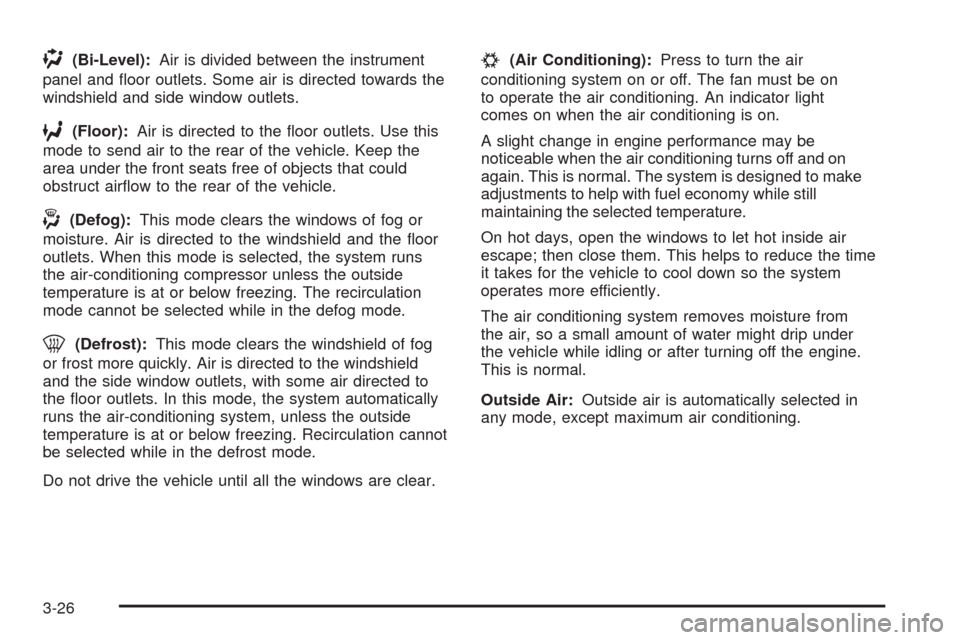
)(Bi-Level):Air is divided between the instrument
panel and �oor outlets. Some air is directed towards the
windshield and side window outlets.
6(Floor):Air is directed to the �oor outlets. Use this
mode to send air to the rear of the vehicle. Keep the
area under the front seats free of objects that could
obstruct air�ow to the rear of the vehicle.
-(Defog):This mode clears the windows of fog or
moisture. Air is directed to the windshield and the �oor
outlets. When this mode is selected, the system runs
the air-conditioning compressor unless the outside
temperature is at or below freezing. The recirculation
mode cannot be selected while in the defog mode.
0(Defrost):This mode clears the windshield of fog
or frost more quickly. Air is directed to the windshield
and the side window outlets, with some air directed to
the �oor outlets. In this mode, the system automatically
runs the air-conditioning system, unless the outside
temperature is at or below freezing. Recirculation cannot
be selected while in the defrost mode.
Do not drive the vehicle until all the windows are clear.
#(Air Conditioning):Press to turn the air
conditioning system on or off. The fan must be on
to operate the air conditioning. An indicator light
comes on when the air conditioning is on.
A slight change in engine performance may be
noticeable when the air conditioning turns off and on
again. This is normal. The system is designed to make
adjustments to help with fuel economy while still
maintaining the selected temperature.
On hot days, open the windows to let hot inside air
escape; then close them. This helps to reduce the time
it takes for the vehicle to cool down so the system
operates more efficiently.
The air conditioning system removes moisture from
the air, so a small amount of water might drip under
the vehicle while idling or after turning off the engine.
This is normal.
Outside Air:Outside air is automatically selected in
any mode, except maximum air conditioning.
3-26